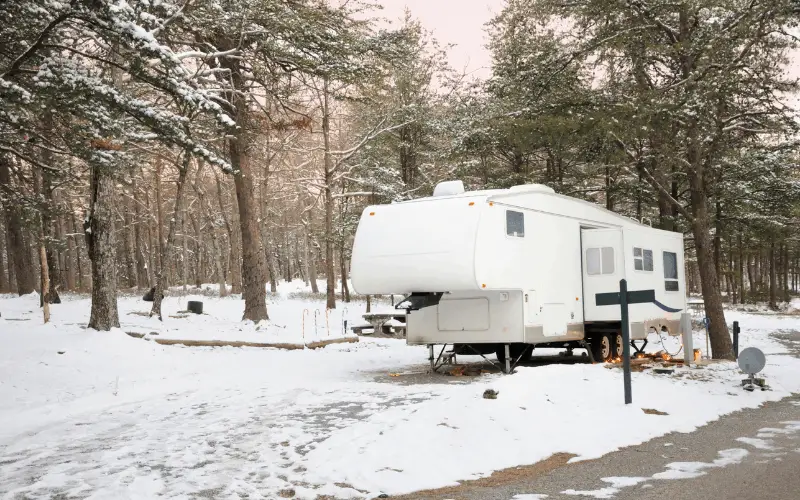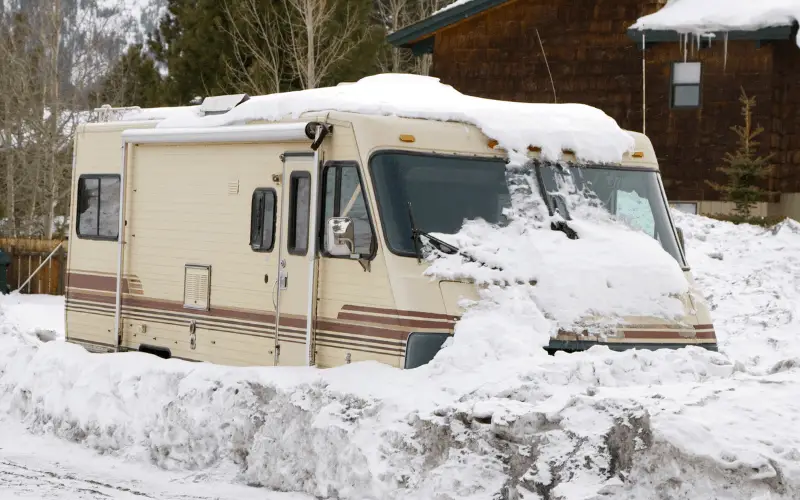Published Date: October 18, 2020
Last Updated on October 22, 2022 by camper front
Winterizing a camper with antifreeze is the most commonly used method, but that comes with a downside. Using antifreeze to winterize your camper during winter may cause some health concerns.
This is primarily because when you use your camper plumbing system next, there might be some residue of antifreeze in the plumbing lines, which can lead to you drinking water mixed with antifreeze. But do you have to use antifreeze to winterize a camper?
Well, yes, you can, but it’s not advisable as there is another safe way to winterize your camper effectively.
Table of Contents
Do You Have To Use Antifreeze To Winterize A Camper?
Like I mentioned above, you can use antifreeze to winterize a camper, but it’s not advisable. Wintering your RV with antifreeze may pose some health risks to you and your household.
So, instead of risking it, why not try another safer way to winterize your RV during winter? Below, we shall be looking at how to winterize a camper without antifreeze. And yes, this other method is 100% safe.
How to Winterize a Camper Without Antifreeze

You will need a couple of tools like wrenches, screwdrivers, and socket wrenches to enable you to reach some of the bolts you will need to loosen; the screwdriver will help you access the valves of your water heater and water pump.
You are also going to need an air compressor that can produce up to 50 psi of pressure. You will also need a blowout plug and a compressor hose attachment that will allow you to connect it to the water lines. Once you get these items ready, it is time to start winterizing your RV.
Empty Your Holding Tanks
This is the first step you need to take when winterizing your camper; you need to empty your black and gray tanks. You can take your travel trailer to a disposal site, connect the gray and black tanks to the intakes, then pull on the release valves.
But you need to empty the black tank first so that the soapy water from the grey holding tank helps clean the waste residue in the drain hose. You can also take a heavy-duty garden hose to the dumpsite so you can rinse out your holding tanks thoroughly after dumping out the waste.
Clean Out The Inside of The Camper
Suppose you will be storing your camper throughout the winter, which could be months on end. You want to make sure you get rid of things like food scraps, dirty dishes, and food containers. Anything that can attract rodents and pests, causing them to wreak havoc in your camper.
The last thing you want to come back to is a rodent-infested and damaged camper. You will also need to close up the windows securely and plug the air vents to prevent birds and small animals from turning your trailer into a warm and cozy home.
You will also need to lower the trailer just enough to cause it to lean to one side a bit so that water will be able to flow out freely from the release valve.
Drain Your Water Line
Next, you need to locate the main water drain in your trailer, known as the petcock; it is usually located underneath the trailer and connected to the water storage tank.
So you need to locate the petcock, then use a wrench to remove it in order to allow the water to flow out, then turn on the hot and cold faucets, the indoor and outdoor shower hose, and flush your toilet a couple of times to get all of the water out of the lines.
You need to leave the faucets open until all the water drains out. Lowering your trailer, so it leans on one side towards the petcock will help the water drain out faster.
Attach the Air compressor
The next line of action is to connect your blowout plug to the air hose of the compressor, then connect the plug into the water inlet of your camper. You will need to set the strength of the compressor to just pump out between 30 to 50 psi as strong air pressure can cause a lot of damage to the plumbing.
You will need someone to go inside the trailer and turn off every tap except the one closest to where you are. This would likely be the kitchen sink. Have them turn on just the hot or cold and let you know when the water has stopped running.
Using the air compressor, blow air through the blow-out valve with a tire pump tip, turn on the compressor and pump air into the plumbing at 30-second intervals, stopping for a couple of seconds before turning the compressor back on.
This will prevent the over-stressing of the pipes. Furthermore, this is also helpful in clearing out any clogs in the plumbing.
Once you are done with one side, turn off one side and turn on the other side and repeat the process. Once the water has stopped running, turn off that sink, move to the next closest, and repeat. Do this with every tap, including the toilet lever.
Once there is no more water but only air coming out of the drain, you can turn off the compressor and then replace the petcock. You will need to wrap some Teflon tape around the threading before replacing the petcock to ensure it seals properly.
But you want to be careful that you do not over-tighten it as that can cause the threading to strip, which can lead to leaking. The last thing to do is close the faucet, shower, and the water inlet valve underneath the toilet.
However, due to the many bends and curves in the pipes, it is difficult for the water to drain completely which leads to water retainment in the plumbing.
Fortunately, the retained water will not be nearly enough to cause damage to your plumbing lines when they freeze, so it is nothing to worry about.
Conclusion
While the usage of antifreeze is commonly practiced with no known serious disadvantage, using antifreeze in your water tanks can make it challenging to get your camper back to using settings for your next camping season.
You will need to repeatedly flush your plumbing lines, and even with that, your water might still smell and taste weird. So, if you have been wondering if you can use antifreeze to winterize a camper, I guess you already know the answer.

